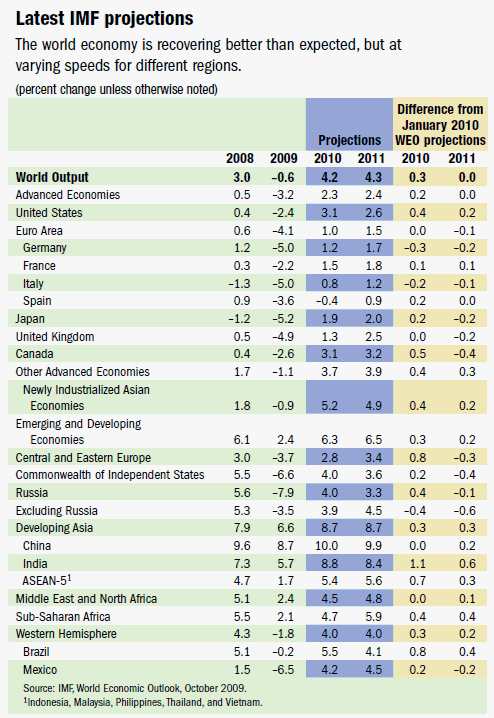
Typical street scene in Santa Ana, El Salvador. (Photo: iStock)
IMF Survey: IMF Raises Forecast for Global Growth, Sees Multispeed Recovery
April 21, 2010
- Global growth forecast raised to 4.2 percent for 2010
- To sustain revival, fiscal stimulus for 2010 should be fully implemented
- But to anchor expectations, medium-term adjustment plans urgently needed
The International Monetary Fund (IMF) says the world economy is recovering from the global crisis better than expected, but sees activity reviving at different speeds in different parts of the world.

Offshore platform construction in Indonesia: Among emerging and developing economies, emerging Asia is leading global recovery (photo: Newscom)
WORLD ECONOMIC OUTLOOK
In its latest World Economic Outlook (WEO), the IMF said among the advanced economies, the United States is off to a better start than Europe and Japan. Among emerging and developing economies, emerging Asia is leading the recovery, while many emerging European and some Commonwealth of Independent States economies are lagging behind (see table).
China’s growth is forecast at 10 percent in 2010, with India also at a rapid 8.8 percent. Sub-Saharan Africa has weathered the crisis well and its recovery is expected to be stronger than in previous global downturns. In the depth of the crisis last year, world economic activity contracted by 0.6 percent as world trade slumped and credit froze up.
“We find ourselves at an important new stage of the crisis,” IMF Research Department Director Olivier Blanchard told an April 21 news briefing in Washington. “A global depression has been averted. The world economy is recovering, and recovering better than we had previously thought likely.” But he added that achieving strong, sustained, and balanced growth would require more work, namely fiscal consolidation in advanced countries, exchange rate adjustments, and a rebalancing of demand across the world.
Outlook still uncertain
The report said that despite improvements, the outlook remains unusually uncertain, and downside risks stemming from fiscal fragilities have come to the fore. A key concern is that room for policy maneuvers in many advanced economies has either been exhausted or become much more limited. Moreover, sovereign risks in advanced economies could undermine financial stability gains and extend the crisis. The rapid increase in public debt and deterioration of fiscal balance sheets could be transmitted back to banking systems or across borders.

These problems underscore the need for policy action to sustain the recovery of the global economy and financial system. Given the still fragile recovery, fiscal stimulus planned for 2010 should be fully implemented, except in economies that face large increases in risk premiums.
The report said the policy agenda should include several important elements.
• Reducing sovereign risk. The key task ahead is to reduce sovereign vulnerabilities. In many advanced economies, there is a pressing need to design and communicate credible medium-term fiscal consolidation strategies. These should include clear time frames to bring down gross debt-to-GDP ratios over the medium term as well as contingency measures if the deterioration in public finances is greater than expected. If macroeconomic developments proceed as expected, most advanced economies should embark on fiscal consolidation in 2011.
• Unwinding the stimulus. Given the large amount of public debt that has been accumulated during this recession, in many advanced economies stimulus exit policies need to emphasize fiscal consolidation and financial sector repair. This will allow monetary policy to remain accommodative without leading to inflation pressure or financial market instabilities. In emerging and developing economies, priorities depend on the room for maneuver on fiscal policy and on current account positions.
• Combating unemployment. As high unemployment persists in advanced economies, a major concern is that temporary joblessness will turn into long-term unemployment. Beyond pursuing macroeconomic policies that support recovery in the near term and financial sector policies that restore banking sector health (and credit supply to employment-intensive sectors), specific labor market policies could also help limit damage to the labor market. In particular, adequate unemployment benefits are essential to support confidence among households and to avoid large increases in poverty. Education and training can help reintegrate the unemployed into the labor force.
• Buttressing financial stability. Policymakers need to try to ensure that the next stage of the financial sector deleveraging process unfolds smoothly and results in a safer, competitive, and vital financial system. Swift resolution of nonviable institutions and restructuring of those firms with a commercial future is key. Care will be needed to ensure that too-important-to-fail institutions in all jurisdictions do not use the funding advantages their systemic importance gives them to consolidate their positions even further. Starting securitization on a safer basis is also essential to support credit, particularly for households and small and medium-size enterprises.
• Agreeing the regulatory reform agenda. Looking further ahead, there must be agreement on the reform agenda for financial regulation. The direction of reform is clear—higher quantity and quality of capital and better liquidity risk management—but the magnitude is not. In addition, uncertainty surrounding reforms to address too-important-to-fail institutions and systemic risks make it difficult for financial institutions to plan. Policymakers must strike the right balance between promoting the safety of the financial system and keeping it innovative and efficient. Specific proposals for making the financial system safer and for strengthening its infrastructure—for example, in the over-the-counter derivatives market—are discussed in the Global Financial Stability Report.
• Tackling global imbalances. The world’s ability to sustain high growth over the medium term depends on rebalancing global demand. This means that economies that had excessive external deficits before the crisis need to consolidate their public finances in ways that limit damage to growth and demand. Concurrently, economies that ran big current account surpluses will need to further increase domestic demand to sustain growth, as excessive deficit economies scale back their demand. As the currencies of economies with excessive deficits depreciate, those of surplus economies must logically appreciate. Rebalancing also needs to be supported with financial sector reform and growth-enhancing structural policies in both surplus and deficit economies.







